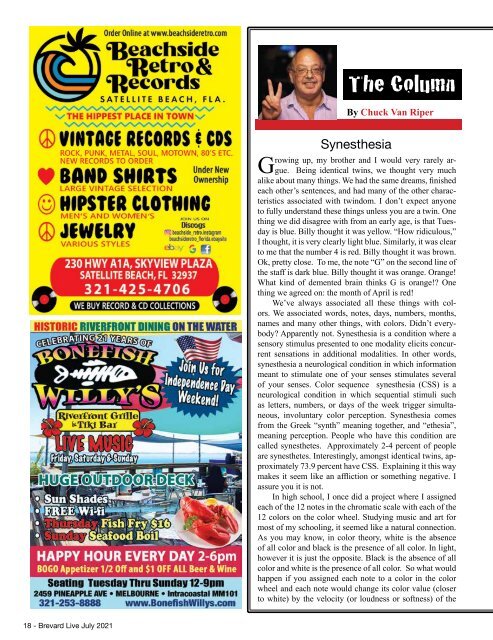Create successful ePaper yourself
Turn your PDF publications into a flip-book with our unique Google optimized e-Paper software.
The Column<br />
By Chuck Van Riper<br />
Synesthesia<br />
G<br />
rowing up, my brother and I would very rarely argue.<br />
Being identical twins, we thought very much<br />
alike about many things. We had the same dreams, finished<br />
each other’s sentences, and had many of the other characteristics<br />
associated with twindom. I don’t expect anyone<br />
to fully understand these things unless you are a twin. One<br />
thing we did disagree with from an early age, is that Tuesday<br />
is blue. Billy thought it was yellow. “How ridiculous,”<br />
I thought, it is very clearly light blue. Similarly, it was clear<br />
to me that the number 4 is red. Billy thought it was brown.<br />
Ok, pretty close. To me, the note “G” on the second line of<br />
the staff is dark blue. Billy thought it was orange. Orange!<br />
What kind of demented brain thinks G is orange!? One<br />
thing we agreed on: the month of April is red!<br />
We’ve always associated all these things with colors.<br />
We associated words, notes, days, numbers, months,<br />
names and many other things, with colors. Didn’t everybody?<br />
Apparently not. Synesthesia is a condition where a<br />
sensory stimulus presented to one modality elicits concurrent<br />
sensations in additional modalities. In other words,<br />
synesthesia a neurological condition in which information<br />
meant to stimulate one of your senses stimulates several<br />
of your senses. Color sequence synesthesia (CSS) is a<br />
neurological condition in which sequential stimuli such<br />
as letters, numbers, or days of the week trigger simultaneous,<br />
involuntary color perception. Synesthesia comes<br />
from the Greek “synth” meaning together, and “ethesia”,<br />
meaning perception. People who have this condition are<br />
called synesthetes. Approximately 2-4 percent of people<br />
are synesthetes. Interestingly, amongst identical twins, approximately<br />
73.9 percent have CSS. Explaining it this way<br />
makes it seem like an affliction or something negative. I<br />
assure you it is not.<br />
In high school, I once did a project where I assigned<br />
each of the 12 notes in the chromatic scale with each of the<br />
12 colors on the color wheel. Studying music and art for<br />
most of my schooling, it seemed like a natural connection.<br />
As you may know, in color theory, white is the absence<br />
of all color and black is the presence of all color. In light,<br />
however it is just the opposite. Black is the absence of all<br />
color and white is the presence of all color. So what would<br />
happen if you assigned each note to a color in the color<br />
wheel and each note would change its color value (closer<br />
to white) by the velocity (or loudness or softness) of the<br />
18 - Brevard Live July 2021


















